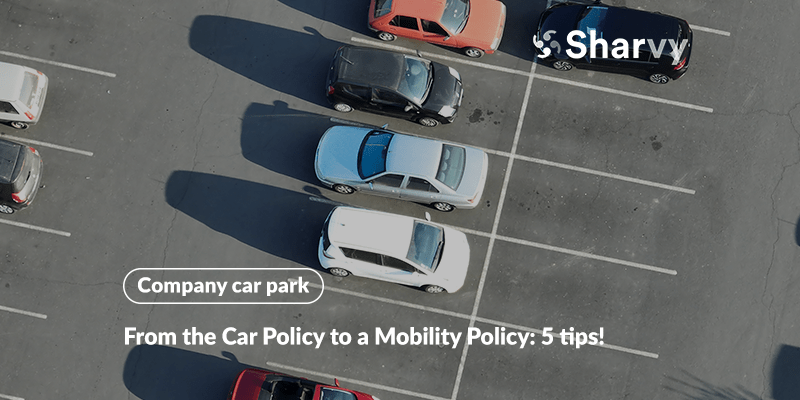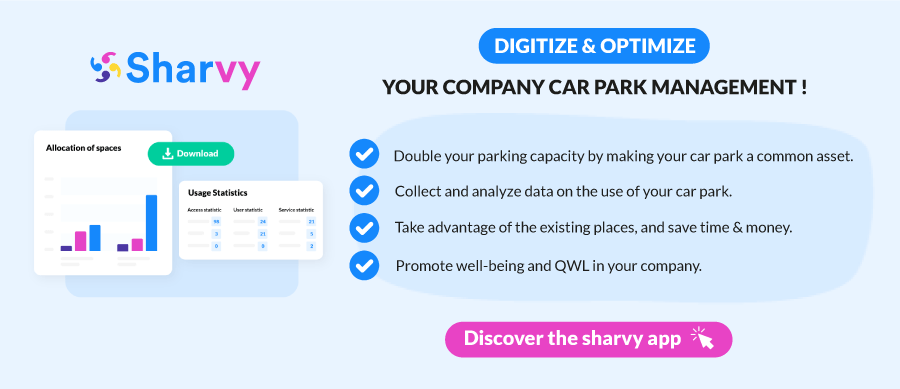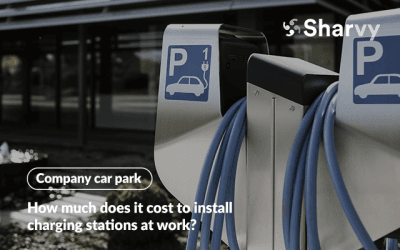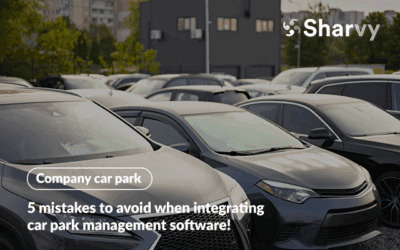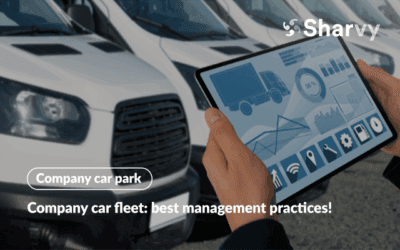Long embedded in rigid parking policies, companies now find themselves in an ever-changing environment where emerging workplace trends intermingle with the challenges of urban congestion and the growing demands for environmental responsibility.
As a result, they must move away from the traditional Car Policy and adopt a new parking policy if they want to retain their employees and stay attractive to their (future) talents.
Moreover historically, parking policies established within the parking lot were based on a standardized & uniform approach, where the allocation of a parking space depended (solely) on the employee’s status, hierarchical position and seniority. This, without taking into account the flexibility of employees’ travel needs.
That’s why this approach is outdated and no longer meets the challenges inherent in corporate parking management. No longer confined to a single travel option, it’s time for a Mobility Policy!
In this article, you’ll find 5 valuable tips to help you develop and implement a successful Mobility Policy – in other words, a multimodal approach to mobility for all employees.
Car Policy vs Mobility Policy : what are the differences?
First, let’s recall what the traditional Car Policy is. In companies, it’s simply a policy focused on managing parking spaces available to employees and visitors. Ultimately, it is limited to the purely material aspect of having vehicles in the parking lot.
It’s purpose It is solely to regulate the use and assignment of parking spaces for individual cars, as historically, this was the primary mode of transportation for employees commuting from home to work. Consequently, most parking policies were designed to meet the growing demand for parking spaces due to the increasing number of vehicles on the roads and in urban areas.
The Mobility Policy, on the other hand, takes a more holistic approach. Instead of limiting itself only to managing parking spaces, it encompasses a range of solutions and measures that promote alternative and sustainable transport modes in corporate parking.
The aim? Reduce the carbon footprint associated with employee travel & offer greater flexibility in the choice of mode of transport (for example: it’s more feasible for employees to buy an electric vehicle if the employer installs shared recharging stations in the company parking lot). As such, it is designed according to rules that can be modulated & customized according to employees’ needs.
Consequently, the main difference between the Car Policy and the Mobility Policy lies in their respective approaches to managing company travel. Whereas the former focuses solely on parking space management, the latter adopts a broader & more inclusive approach, favoring multimodal, sustainable & accessible mobility for all employees.
But what are the limits of the traditional Car Policy?
Although (still) dominant within companies, the Car Policy has many limitations, which are highlighted in the following paragraphs.
On the one hand, changes in the regulatory framework and in social and environmental expectations are driving companies to adopt more sustainable mobility practices. However, the traditional car policy is, by its very nature, a car-centric parking policy. As such, it unintentionally excludes employees who wish to take advantage of the parking lot and use alternative means of transport.
As a result, the Car Policy limits employees’ travel options and may even accentuate dependence on the private car. This, in turn, can exacerbate the problems of traffic congestion, air pollution and urban environmental degradation.
On the other hand, technological advances & the emergence of alternative mobility solutions offer new opportunities for companies. They can diversify their parking policies and facilitate the use of these solutions.
Options such as electric vehicles and the installation of shared charging stations, car-sharing, bike and scooter sharing services, as well as parking management applications like Sharvy, are helping to rethink the way employees get to work. This makes it possible to transform the company parking lot into a genuine mobility hub, benefiting a wide range of users. However, this is a point that the Car Policy also ignores.
What’s more, the changing needs & preferences of employees in terms of mobility make it necessary to adopt a more flexible & personalized parking policy. Unlike the Car Policy, which is rather rigid and set in stone.
This is why the transition from a Car Policy to a Mobility Policy seems inevitable. Companies are adapting to changing societal demands, technological advances and (new) employee needs. This transition marks an important step towards a more sustainable, flexible and inclusive working environment.
How to reinvent your parking policy towards a “Mobility Policy”?
1. Define your Mobility Policy vision.
No doubt: defining YOUR vision of the Mobility Policy is the obvious starting point for a successful (re)structuring of your parking policy.
To do this, involve the essential stakeholders from the very beginning. Engage the Purchasing Department, the Human Resources Department (HRD), the members of the Executive Committee, and other decision-makers. Gather their feedback and suggestions on the upcoming changes.
During a dedicated meeting, start by presenting the objectives of a Mobility Policy today.
Specify that it must first encourage the diversification of transportation modes.This helps to reduce the carbon footprint associated with employee commuting as much as possible. Consequently, the Mobility Policy must facilitate carpooling, the use of electric or plug-in hybrid vehicles, the use of two-wheelers, and other alternatives to individual cars.
In parallel, also mention that it aims to make employee commuting more efficient and smoother. For example, integrate digital and connected solutions, like a parking space reservation app. This app offers a real-time view of parking availability in your company’s lot.
Finally, specify that a Mobility Policy must focus on accessibility and inclusivity. Ensure that the company’s parking policy does not exclude (or even prioritize) parking access for people with disabilities, pregnant women, and those living in remote areas with limited public transportation.
Once all decision-makers are aware of these objectives, you can discuss what is realistically achievable within your company. Consider costs with the Purchasing Department, environmental goals with the CSR Department, or employee needs with HR.
2. Integrate new technologies into your corporate mobility management
In today’s digital age, integrating new technologies into the management of corporate parking lots should not be overlooked, as it offers considerable advantages.
For example, it’s no news that today, the time required to find a parking space represents as much time lost as pollution emitted by the vehicle. It is therefore important to rethink usage to reconcile the need to free up space with the parking needs of a user.
As a company, you have a direct impact on the mobility of your employees. Therefore, by integrating a Parking Management application accessible to all, you can easily optimize your parking infrastructure and enforce the new rules of your Mobility Policy. Let’s consider an example:
- Situation? Without these technologies, your company’s parking often operates on the FIFO (First In, First Out) model. In this context, your employees cannot know in advance the availability of parking spaces within the lot. It’s only when they are on site that they realize the problem.
- Consequences? They desperately make several rounds of the parking lot before finding a free space (if they’re lucky), because otherwise, they’ll have to resort to parking their car on the street
- Solution? By integrating new technologies into the management of your parking, like the Sharvy solution, your employees can remotely check the availability within the company’s parking lot. More importantly, they can plan their mobility. If the parking lot is full on a specific day, they can decide to use public transportation. This avoids wasting time searching for a parking space. Moreover, Sharvy allows holders of parking spots to retain this privilege. They can share their parking space on days they do not go to the office, and therefore, do not use their parking space. Non-holders can then make a reservation and benefit from the company’s parking.
Thus, by integrating digital technologies, you promote the rotation of parking space usage, which leads to less reluctance from the holders to use public transportation, as well as to favor softer mobilities. And this, without losing the use of their parking space, which promotes multimodality.
3. Create incentive & deterrent policies.
Thus, by integrating digital technologies, you promote the rotation of parking space usage. This leads to less reluctance from the holders to use public transportation, as well as to favor softer mobilities. And this, without losing the use of their parking space, which promotes multimodality.
At this stage, your goal is to target the measures that will form the pillars of your Mobility Policy. For example, you can create various policies.
Incentive policies, by encouraging more rational car use by your employees while promoting smarter mobility. For instance, you could guarantee a reserved parking space for employees who carpool. This might be particularly useful if your company is in a high-demand urban area with limited street parking. It offers a practical and motivating advantage for employees who choose this commuting option.
Alternatively, you could also subsidize part or all of the cost of public transportation passes. This can encourage your employees to opt for this mode of transportation.
Deterrent policies can also be introduced to discourage excessive use of individual cars and encourage the adoption of more sustainable transportation modes. For instance, you could eliminate certain individual car-related benefits, such as fuel reimbursement. You could also impose charging fees for electric & plug-in hybrid vehicles. Although this approach is more stringent, it can be highly effective.
Ultimately, there’s no need to choose between the first and the second policy. You can also think of other options. However, keep in mind that deterrent policies might be more effective in environments where positive incentives aren’t enough to induce significant behavioral changes. This is particularly true when road congestion & air pollution require more restrictive measures.
4. Install Infrastructure for Diversified Mobility.
If you want to promote a sustainable and effective parking policy, consider installing infrastructure for diversified mobility. Moreover, this addresses the growing need to offer varied commuting options to your employees, considering their needs & individual preferences.
For instance, by installing shared recharging stations for electric & plug-in hybrid vehicles, bike racks, and carpooling spaces, you offer your employees the ability to choose from a range of transportation options. This options best suit their needs and values. What’s more, you’re promoting electric mobility.
Additionally, installing such infrastructure contributes to promoting a corporate culture centered on sustainability & CSR. By showing a commitment to sustainable mobility, you send a strong message to your employees, clients, and the surrounding community. You demonstrate a willingness to take concrete steps to reduce your carbon footprint & to promote a more environmentally-friendly (professional) lifestyle.
5. Regularly Evaluate & Adjust Your « Mobility Policy ».
It is important to identify the strengths & weaknesses of your parking policy. This ensures your company stays flexible (and responsive) to changing employee needs.
That’s why you need to regularly collect various data on parking usage. This can be easily done by digitizing parking management, as mentioned earlier. Thus, you’ll obtain various usage data (occupancy statistics, the number of reservations per user & by type of spot, activity history, space-sharing rates, etc.) to help make the right decisions about managing it.
You could also identify trends & potential challenges, such as behavior patterns. For example, you might notice that Tuesday & Thursday are the days when the company’s parking lot is the emptiest (due to remote work). In contrast, Wednesday is the day when individual cars are used the most, and the parking lot is under pressure. Many employees have obligations with their children (no school & activities on that day), so cars are one of the most practical solutions. By knowing these trends, corrective measures can be implemented to make life easier for your employees.
In parallel, remember to check your Mobility Policy results against the objectives established at the outset with your company’s decision-makers. Identify necessary adjustments based on evolving needs & circumstances.
In conclusion
No doubt: by abandoning rigid parking policies that focus solely on individual cars, companies pave the way for more flexible, inclusive & environmentally-friendly mobility.
Moreover, with the rise of remote work, flexible schedules, and hybrid work models, employee commuting patterns have become more diverse and complex. The traditional Car Policy is no longer suitable for this changing reality. The Mobility Policy, therefore, becomes essential.
Any questions ? Check out the following FAQ !
What are the potential challenges facing companies as they make the transition to a Mobility Policy?
Transitioning to a Mobility Policy can present several challenges for companies. First, there may be resistance to change among employees used to traditional car-oriented parking policies. Convincing them of the benefits of a more diverse mobility approach might require effective communication & active engagement from management.
Additionally, implementing a Mobility Policy may require considerable initial investment. This includes alternative transport infrastructure, like electric vehicle charging stations, as well as facilities for carpooling.
Finally, companies need to be aware of regulatory requirements & compliance standards related to mobility. This can add an extra layer of complexity to the transition. By overcoming these challenges with careful planning & a proactive approach, companies can successfully implement a Mobility Policy. This meets their employees’ needs while contributing to more sustainable & efficient mobility..
How can a Mobility Policy contribute to improving employee health & well-being?
No doubt: by encouraging active transportation modes like cycling & walking, a Mobility Policy can help promote a more active lifestyle for employees. Regular exercise can reduce the risks of chronic illnesses such as obesity, cardiovascular diseases, and diabetes. It also improves mental health & overall workplace well-being.
Moreover, reducing stress related to commuting by promoting more efficient and less stressful transportation options can also contribute to enhancing employees’ daily lives.
Want to learn more? Check out our latest articles to stay up to date!
How much does it cost to install charging stations at work?
What is the real cost of installing charging stations in a business? How can you optimise your investment? Here are the answers!
5 mistakes to avoid when integrating car park management software!
What are the 5 most common mistakes to avoid before and during the integration of parking management software? Focus!
Company car fleet: best management practices!
Should you electrify, pool or automate your company car fleet? What are the best management practices? Let’s take a closer look!
Subscribe to our newsletter!
Resources
Contact us

